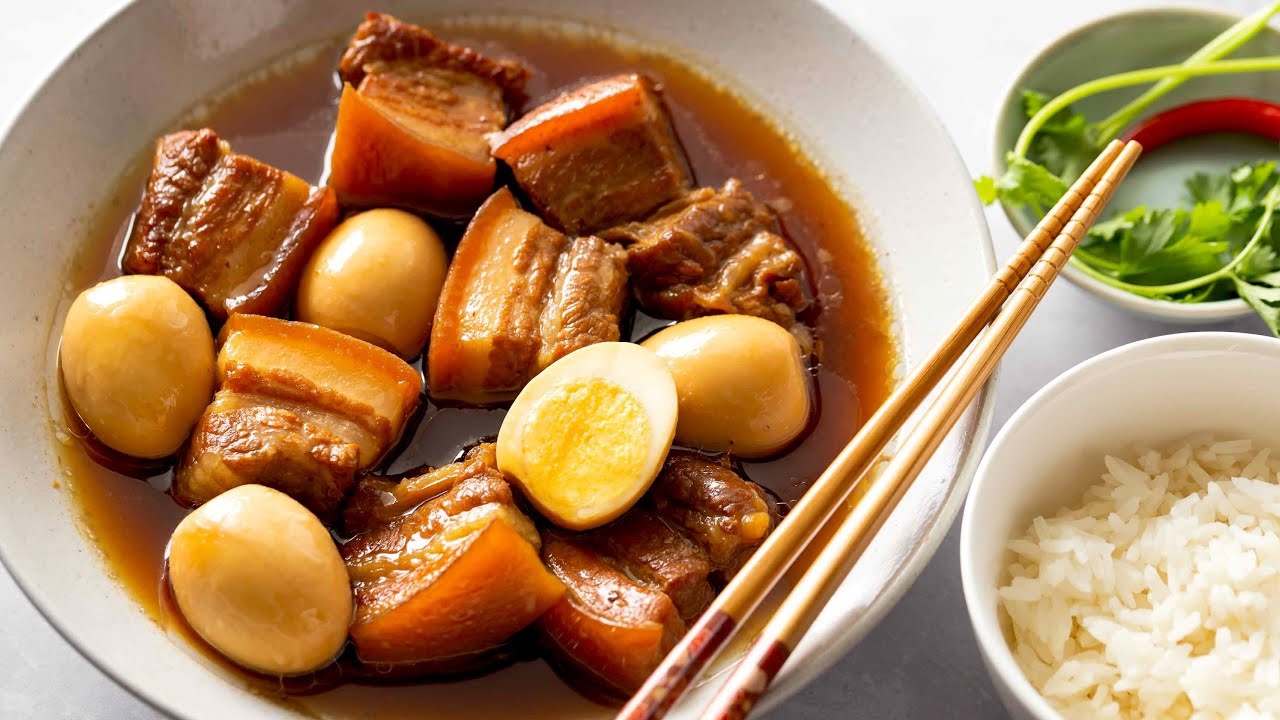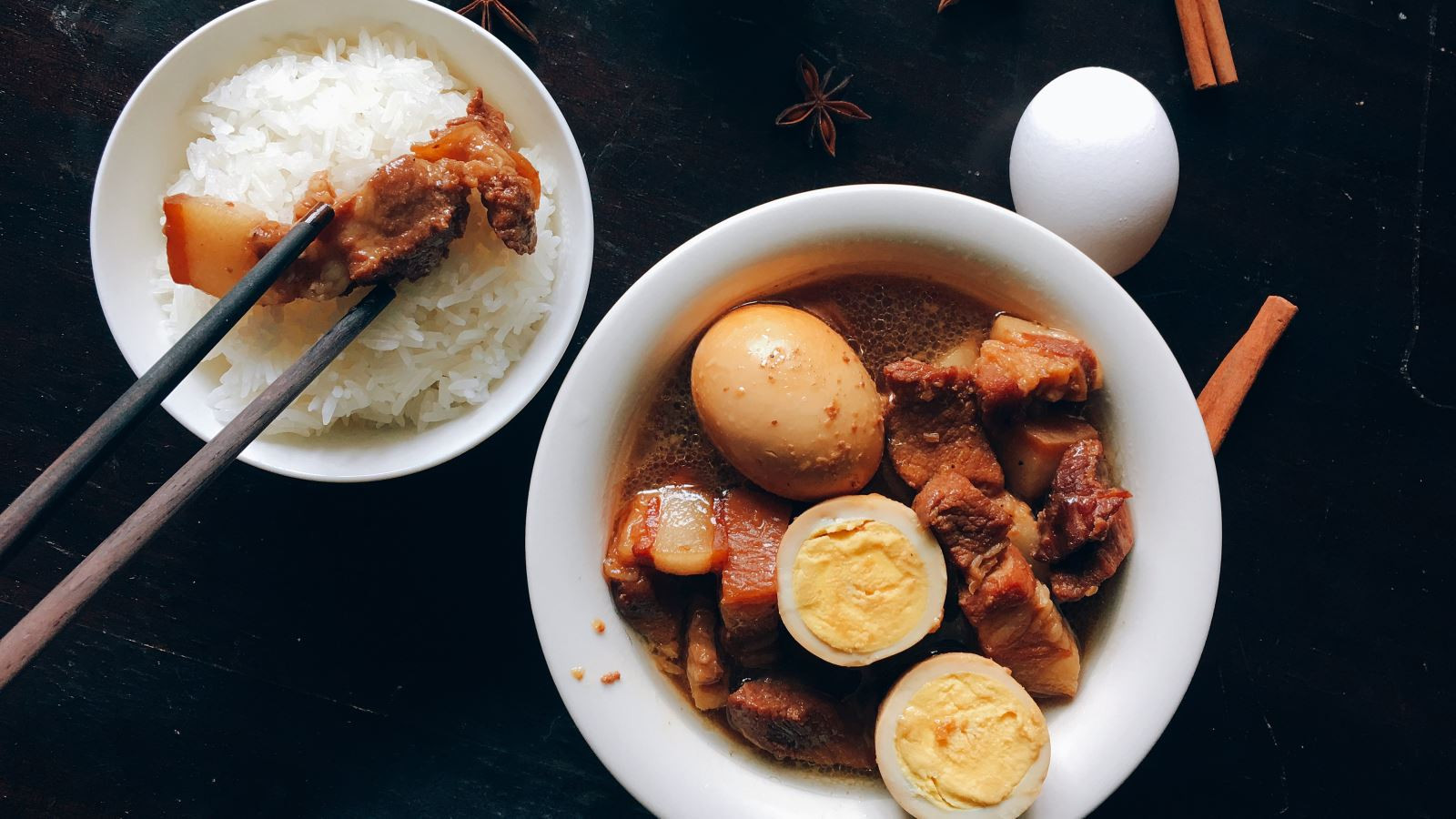Marinated with a harmonious blend of ingredients, Vietnamese braised pork belly is a must-try dish. This iconic dish showcases the art of slow cooking, transforming pork belly into a delectable delicacy.
Vietnamese braised pork belly, known as thịt kho tàu, is a culinary masterpiece that holds a special place in the hearts and tables of many Vietnamese households. This traditional Vietnamese food boasts a delightful combination of tastes and textures and reflects the culinary artistry and cultural heritage of Vietnam travel.
1. What is Vietnamese braised pork belly?

Thịt kho tàu is often thought to be of Chinese origins, as “tàu” literally means “Chinese” in Vietnamese. But this dish actually originates from Vietnamese culinary traditions.
There are various folk tales about the origin of thịt kho tàu. One popular version recounts the story of coastal villagers, who, during their lengthy sea voyages, cooked a large pot of pork stew to sustain them for months at sea. Another version suggests that through verbal linguistic variations, “tàu” also means a salty-sweet flavor.
Vietnamese braised pork belly is especially important during the Tet Holiday in Vietnam. Featuring pork belly or other cuts with a balance of lean meat and fat, sliced into large squares and accompanied by plump duck eggs, this dish symbolizes peace. Moreover, its presence on the festive meal table fosters warm conversations, creating a harmonious atmosphere.
2. The authentic Vietnamese braised pork belly recipe
2.1. Ingredients for thit kho

- Pork belly
- Chili peppers
- Finely chopped purple onions
- Finely chopped garlic cloves
- Fish sauce
- Salt, sugar, MSG, broth powder, pepper
To make a delicious dish of Vietnamese braised pork belly, it is advisable to choose fresh, quality pork belly. Good pork should have a vibrant pink color, not too red or too pale. If the pork appears pale, has a greenish tint, or emits a foul odor, it indicates spoilage.
Additionally, opt for pork with a firm texture and high elasticity. You can test this by pressing your finger into the meat; if it quickly springs back without being sticky, watery, or releasing any liquid, it is fine. When preparing braised dishes, choosing pork belly, shoulder, or ham is preferable.
You can add chicken eggs, duck eggs, or quail eggs, and use sugarcane juice or coconut water to enhance the flavor. Some variations may include additions like bamboo shoots, turnips, and other ingredients based on personal preferences.
2.2. Instructions for thit kho
- Rub salt on the pork belly, then rinse it with clean water.
- Boil a pot of water. Once it is boiling, put the pork in, and briefly blanch it with high heat for about 3 minutes. Remove the pork and rinse it again with clean water.
- To eliminate the odor of the pork, briefly blanch it in boiling water for about 3 minutes with a crushed purple onion. The onion effectively helps neutralize the odor.
Alternatively, you can use alcohol. Add a little alcohol to the boiling water before taking out the pork. Afterward, rinse the pork with cold water.
- Once the pork is washed with clean water, cut it into bite-sized pieces and place it in a large bowl.
- Add 1 teaspoon of sugar, 1 teaspoon of MSG, 1 teaspoon of broth powder, and 1 teaspoon of pepper. Mix everything evenly.
- Add the chopped purple onion and garlic, mix well, and let it marinate for about 20 minutes.
Note: If time allows, you can also marinate the pork in the refrigerator overnight for a more flavorful result.
- Put sugar into the pot along with 1 tablespoon of water to make caramel.
- When the caramel turns a beautiful brown color, add the pork and stir-fry until the meat is slightly browned. Then, pour 150 milliliters of water and add chili.
- After about 10 minutes of cooking, add 1 tablespoon of fish sauce, reduce the heat, and continue cooking for 2 more minutes.
- When the pork broth boils again, season it to taste, turn off the heat, and add another tablespoon of pepper.
3. Differences in Vietnamese braised pork belly in the North and South

The Northern region typically uses pork ham for Northern Vietnamese braised dishes, while people in Southern Vietnam prefer pork belly. Pork slices are usually larger, about three times the normal size and marinated with spices, fish sauce, sugar, pepper, garlic, and onions in appropriate proportions.
Southerners often use coconut water to cook thịt kho tàu, as coconut in the Mekong Delta is readily available and easy to obtain. Coconut water has an aromatic flavor, contrasting with the sweetness of sugar and reducing the salty taste of fish sauce. When cooking, coconut water is poured until it covers the meat completely. Once the meat is nearly cooked, eggs are added and simmered over low heat. The meat, soaked in coconut water, becomes tender, with a natural golden-brown color, eliminating the need for artificial food coloring.
4. What does braised pork belly taste like? How to enjoy it?

Vietnamese braised pork dish has a rich, savory, and slightly sweet flavor. It can be eaten with:
- Rice: Thịt kho tàu and white rice are a great pair. White rice not only complements the flavor of braised pork but also makes the meal nutritious, preventing it from becoming too heavy.
- Pickled vegetables: Eating thịt kho tàu with pickled vegetables adds a refreshing element. The crisp and slightly sour taste of pickled vegetables effectively counteracts any potential heaviness.
- Fresh vegetables: Combining thịt kho tàu with fresh vegetables enhances the dish’s appeal. The addition of vegetables balances the fatty taste of the braised pork.
- Boiled vegetables: Pairing thịt kho tàu with boiled vegetables creates a fiber-rich dish. The boiled vegetables not only contribute to a well-balanced meal but also alleviate any sense of heaviness.

